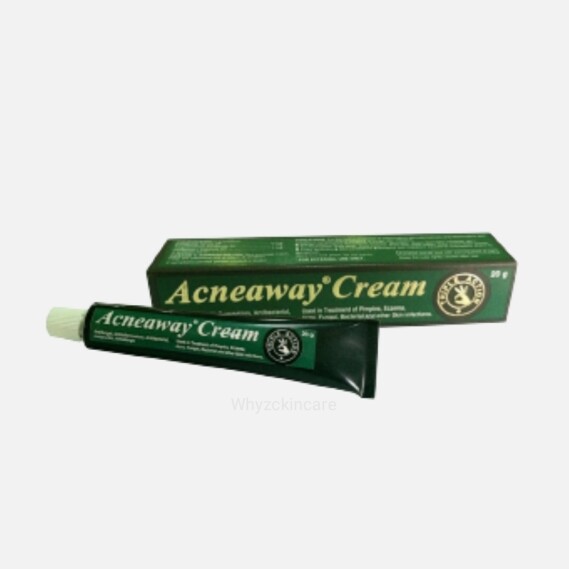Acneaway cream contains dematomycosis agent i.e, antifungal, antibacterial and corticosteroid. It is well absorbed on topical application.
Econazole nitrate is a broad-spectrum antifungal agent with activity against many gram-positive bacteria.
Triamcinolone acetonide is a potent corticosteroid with anti-inflammatory, antipruritic and antiallergic activity.
Gentamicin sulphate is a wide-spectrum antibiotic, which provides highly effective treatment in primary and secondary bacterial infections of the skin.
INDICATIONS
For the topical treatment of inflammatory dermatomycoses and inflammatory skin conditions complicated by bacterial or fungal skin infection:
Allergic inflammatory dermatoses (eczema, dermatitis, diaper dermatitis, intertrigo, etc)
Trychophytosis: tinea pedis, tinea corporis, tinea faciei, tinea capitis, tinea cruris, tinea sycosis.
Tinea versicolor
Skin candidiasis
Bacteria skin infections caused by susceptible strains to gentamicin.
CONTRA-INDICATIONS
Hypersensitivity to any of the component of formulation
Patients with tuberculosis cutis, herpes simplex, varicella, herpes zoster, vaccinia and syphilis.
Eczematous otitis extema with perforated eardrum.
Ulcer (Behcet's disease), burn (exceed 2o)
Patients who have previously exhibited hypersensitivity to aminoglycoside antibiotic (such as Streptomycin, Neomycin, Kanamycin and Gentamicin) and Bacitracin.
PRECAUTIONS/WARNINGS
Long-term continuous therapy, particularly occlusive dressings, should be avoided since it may cause side effects similar to systemic administration of corticosteroid.
Avoid long-term therapy: the overgrowth of non-susceptible organisms, including fungi, occasionally occurs with the use of topical antibiotic. If this occurs, or if irritation, sensitization, or super infection develops, treatment should be discontinued and appropriate therapy instituted.
If the symptom aren't being improved or are aggravated, discontinue the therapy.
If the symptom is improved, change the drug to other non-steroidal drug as soon as possible.
ADVERSE EFFECTS
Safe and well tolerated. Rarely, some patients may show mild to moderate irritation (erythema and pruritus) that do not usually require discontinuation of treatment.
Other dermal symptoms: Long-term therapy may cause steroidal acne, steroidal skin (skin atropy, telangiectasis) and changes of the skin such as thinning, purpura, hirsutism and hypopigmentation. Such symptoms may occur slowly, decrease the dosage of this drug and change to non-steroidal drugs.
HPA axis dysfunction: Long-term therapy or occlusive dressings may cause hypothalamus pituitary-adrenal (HPA) axis suppression.
DOSAGE & ADMINISTRATION
Apply to the affected area once to several times daily as directed by the physician.
STORAGE/HANDLING RECOMMENDATIONS
Store in a cool place. Do not freeze. Keep the tube tightly closed after use.
Keep out of the reach of children.
Clotrimazole: Clotrimazole is a broad-spectrum antifungal agent that is used for the treatment of dermal infections caused by various species of pathogenic dermatophytes and Malassezia furfur. The primary action of Clotrimazole is against dividing and growing organisms.
In vitro, Clotrimazole exhibit fungistatic and fungicidal activity against isolates of Trichophyton rubrum, Trichophyton mentagrophytes, Epidemophyton floccosum and Microporum canis.
Beclomatosone dipropionate: Beclomathasone dipropionate, a corticosteroid, is effective in the treatment of corticosteroid-responsive dermatoses primarily because of its anti-inflammatory, antipruritic, and vasoconstrictive actions.
Gentamicin Sulfate: Gentamicin sulfate, a wide-spectrum antibiotic, provides highly effective topical treatment in primary and secondary bacterial infections of the skin.
Pharmacokinetics:
The extent of percutaneous absorption of topical corticosteroids is determined by many factors including the vehicle, the integrity of the epidermal barrier, and the use of occlusive dressings.
Topical corticosteroids can be absorbed from normal intact skin; inflammation and/or other disease processes in the skin increase percutaneous absorption. Occlusive dressings substantially increase the percutaneous absorption of topical corticosteroids.
Corticosteroids are bound to plasma proteins in varying degrees. Corticosteroids are metabolized primarily in the liver and are then excreted by the kidneys. Some of the topical corticosteroids are also excreted into the bile.
INDICATIONS
Visita Plus cream is used in all commonly encountered dermatoses with bacteria and/or fungal infection, mixed dermatoses, contact dermatitis, atopic dermatitis (eczema), chronic otitis externa, Candidiasis and napkin rash.
CONTRA-INDICATIONS
Visita Plus cream is contra-indicated in patients who are sensitive to Beclometasone dipropionate, Clotrimazole, Gentamicin sulfate, other corticosteroids or imidazole, or to any other ingredients in this preparation.
PRECAUTIONS/WARNINGS
General: Systemic absorption of topical corticosteroids has produced reversible hypothalamic-pituitary-adrenal (HPA) axis suppression, manifestation of Cushing's syndrome, hyperglycemia, and glucosuria in some patients.
If irritation or hypersensitivity develops with the use of Visita Plus cream, treatment should be discontinued and appropriate therapy instituted.
Pregnancy category (US FDA): Category C: Should be used in pregnant women only if the potential benefit justifies the potential risk to the foetus.
INTERACTIONS
Drug interactions have not been reported. However, check with your doctor or pharmacist before use to ensure that the combination is safe. Especially pay attention to cancer chemotherapy agents, other topical medications and vitamins.
ADVERSE EFFECTS
The local adverse effect reported infrequently are burning, itching, irritation, dryness, folliculitis, hypertrichosis, acneiform eruptions, hypopigmentation, perioral dermatitis, allergic contact dermatitis, maceration of the skin, secondary peeling edema, pruritus, urticaria, and general irritation of the skin.
DOSAGE & ADMINISTRATION
Gently massage sufficient Visita Plus cream into the affected and surrounding skin area twice a day, in the morning and evening. For two weeks in tinea cruris and tinea corporis; and for four weeks in tinea pedis. The use of Visita Plus cream for longer than four weeks is not recommended.
OVERDOSAGE:
Acute overdosage with topical applications of Visita Plus cream is unlikely and would not be expected to lead to a life-threatening situation.
Topically applied corticosteroids can be absorbed in sufficient amounts to produce system effects.
STORAGE/HANDLING RECOMMENDATIONS
Store between 2oC and 30oC.
Keep away from the reach of children.



Add your review